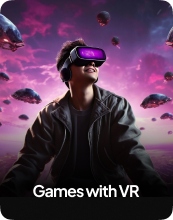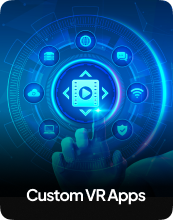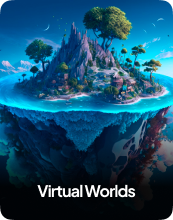
Software Development


Embark on an amazing adventure with Virtual Reality. From realistic training environments to stunning virtual tours, our VR solutions are created to transport you and your customers to new and exciting worlds. Our skilled and creative VR developers guarantee a smooth and captivating experience that goes beyond the screen. Fill up your business with experiences that are not only visual, but also felt. The future is here, and it's virtual.






#1
Begin by assessing your business requirements. Determine areas where VR technology can address specific challenges or enhance existing processes. This could range from training, product design, customer engagement, to marketing initiatives.
#2
Engage with our team of VR experts. Discuss your goals, challenges, and vision for how VR can benefit your business. Our experts will work closely with you to develop a customized VR solution. This may involve a combination of hardware, software, and content creation to meet your specific needs.
#3
Determine the specific feature and functionalities you want in your VR solution. This could include interactive environmen ts, simulations, data analytics, or other specialized components tailored to your business objectives.
#4
Once the requirements and features are defined, our team will initiate the design and development phase. This involves creating the VR environment, integrating hardware components, and developing software applications or experiences.
#5
We will craft a unique VR business solution tailored specifically to your organization. This solution will be designed to address your identified needs and challenges.
#6
Get feedback from stakeholders so you can refine it. Once the VR solution is perfected, it's time for the official launch. Our team will oversee the deployment, making sure everything works.


VR can create memorable and interactive experiences for customers, leading to higher brand engagement and conversion rates.

In industries like architecture, automotive, and healthcare, VR can significantly reduce the costs associated with physical prototypes, models, and simulations.

You can visualize and interact with 3D models in VR, enabling rapid prototyping, iterations, and refinements.

VR leads to higher conversion rates and increased customer satisfaction, as it provides a more engaging and memorable experience compared to traditional methods.

VR can provide virtual access to places that are difficult, dangerous, or costly to reach in person.

VR platforms can collect valuable data on user behavior and interactions, providing businesses with insights to optimize their products and services.
Augmented reality (AR): a view of the real world—physical world—with an overlay of digital elements. Mixed Reality (MR): a view of the real world—physical world—with an overlay of digital elements where physical and digital elements can interact. Virtual reality (VR): a fully-immersive digital environment.
Here are some of the VR vendors making waves in the industry as of 2023:
RealWear
Meta
Apple
Goertek
Pimax
Pico
HP.
HTC Vive
360 VR is only for the eyes to enjoy and ears to hear, meaning you can't interact with the environment.On contrast, 3D VR is created or produced digitally. 3D environments are produced using computer software and artificial intelligence that replicate real world or give rise to completely new environments.
Other notable examples of VR headsets include Oculus Rift, Samsung Gear VR, HTC Vive, Google Daydream View, or Google Cardboard. These headsets remove vision of the real world and provide video to each eye allowing for depth of vision.
China spends the most on VR. Of the estimated $72.8 billion projected to be spent on AR and VR in 2024, China is expected to account for 36% of that. However, the U.S. and Western Europe are close behind China and are expected to start catching up by 2024, thanks to five-year CAGRs of 75.1% and 72.8%, respectively.
Drive innovation through VR collaborations.

Get our rates card

Thanks for contacting us!
Your request has been submitted, please wait for a response.
